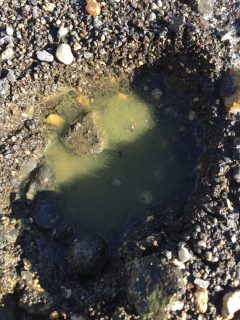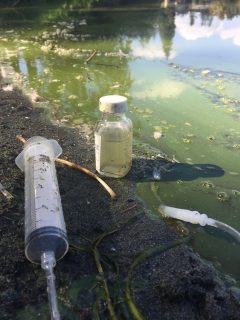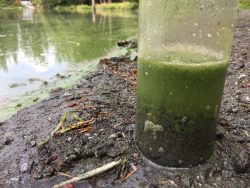by Joan Hardy, Toxicologist (retired), Washington Department of Health, Will Hobbs, Senior Scientist, Washington Department of Ecology, & Ellen Preece, Limnologist, Robertson-Bryan, Inc, Sacramento,CA

Photo showing the presence and accumulation of Microcystis in shoreline sediments; concentrations of MCs were higher in porewaters than in shoreline surface waters.
People want to swim in lakes and play on lake beaches, but these days they have to check for algae blooms before jumping in since cyanobacteria can produce toxins that could harm lakes users. Primary exposure routes are through accidental ingestion of water during recreational activities and contaminated drinking water from public water systems that do not adequately remove cyanotoxins. In Washington, cyanotoxins have been documented in many recreational lakes throughout the state, the most prevalent of which are the liver toxins microcystins (MCs).
Another possible route of exposure to cyanotoxins has not been assessed previously – incidental ingestion of sediments and beach porewaters, defined as the water that fills pores between grains of sediment. Children may be most susceptible to cyanotoxins through this exposure pathway since they are known to swallow dirt, dust, or sand on their hands and toys after putting them in their mouths. Children are also more likely to play along shorewaters of recreational beaches.

Photo showing the in situ porewater sampling device and sample. Porewaters at this location on this date had lower concentrations of MC in porewaters compared to shoreline surface waters. Shoreline accumulations of Microcystis are evident.
To determine whether incidental ingestion of beach porewaters and sediments poses a health risk to children, we sampled sediments, porewaters, and shoreline surface waters on recreational beaches from seven Washington lakes and reservoirs to detect MC presence or absence during or immediately following cyanobacteria blooms. At all seven sites we found MCs in recreational beach sediments proportional to the levels measured in the shoreline waters. When shoreline accumulations of MCs dissipated, leaving lower levels of MCs in surface waters, we found that MC concentrations in sediments and porewaters remained higher than surface water concentrations for the next 20 days.
We performed a human health assessment on total MC concentrations found in porewaters and shoreline sediments, focusing on children as the most sensitive population being exposed. Numerous conservative (protective) default values were assumed in assessment calculations. The maximum ingestion dose calculated using very high lake levels of MCs (Spanaway Lake on September 12, 2018: 4,174 µg/L –using an ELISA assay) was found to be below levels estimated to cause harmful health effects. Thus, accidentally ingesting MCs in sediment and porewater from Washington State lakes at concentrations sampled in 2018 is not expected to harm the health of children or people of any age.

A core tube used to sample composite sediment samples in Spanaway Lake, Pierce County. Overlying water shows heavy accumulation of MCs.
Although accidentally eating and drinking contaminated sediment and porewaters from study lakes is unlikely to result in health effects, people could continue to be exposed to MCs though other routes like swimming or recreating in the lakes during toxic blooms. Therefore, lake users need to take precautions to reduce overall exposure to MCs, and lake managers and local, state, and federal agencies should educate residents about hazards posed by such exposure.









